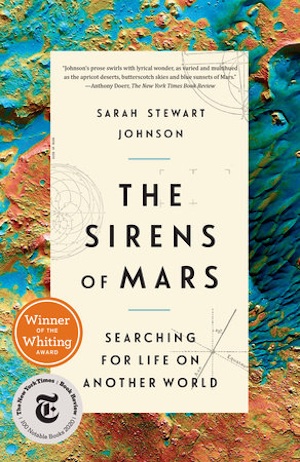Winner of the 2021 Phi Beta Kappa Award in Science
By Benjamin Franklin Martin
“We are seeking places where secrets are held . . . . an almost existential endeavor to confront our own limitations, to learn what life really is, and ultimately to defy our own isolation in the universe.” So insists Sarah Stewart Johnson to explain herself as a planetary scientist inspired not only by a fascination with Mars but by the reading of Herodotus, Voltaire, Blake, Kierkegaard, Dostoyevsky, and Saint-Exupéry. Her quest has been, she writes, “a shimmering hope that life might not be an ephemeral thing, even if we are.”
The siren call of Mars was heard by the most ancient star gazers, but serious investigation began only in the early 1600s when Galileo, using a primitive telescope, was the first to see the fourth planet of our solar system as “a spherical body illuminated by the sun.” When telescopes improved, Christiaan Huygens drew a map of its surface in 1659, William Herschel observed white polar ice caps in 1784, and Giovanni Schiaparelli reported dark passages he called “canals” in 1877. By the beginning of the 20th century, astronomers Camille Flammarion in France and Percival Lowell in the United States had popularized the idea that these canals implied not just life on Mars but a civilization.
These observations and hypotheses were tested by a series of American spacecraft beginning with Mariner 4 in 1965, which sent back from Mars orbit the first photographs of the landscape. Although the widely published images generated great public excitement—Pope Pius VI exclaimed “vidimus et admirati sumus” (we saw and we gazed in wonder)— scientists considered them evidence of a “dead planet.” The hope of finding life flared briefly when the Mariner 9 mapping mission in 1971 revealed volcanoes with calderas, deep canyons, high mountains, and even riverbeds, but Viking 1 and Viking 2, which landed on the Mars surface in 1976, dampened it when their experiments found no trace of organic molecules.
Hope was dampened, not extinguished, because geology provided a reprieve. In 1992, meteorite ALH84001, discovered in Antarctica eight years earlier, was proved to have originated on Mars during the early formation of the solar system. In 1996, analysis of its composition found carbonates, magnetic minerals, and polycyclic aromatic hydrocarbons, “the kind of chemistry conducive to life.” A new series of spacecraft accumulated evidence from Mars itself. In 1997, Pathfinder and the first surface rover, Sojourner, showed how both water and wind had molded the surface. In 2004, rovers Spirit and Opportunity located water-lain deposits, by which the geologic history of Mars could be traced. When particles of perchlorate, destructive of organic material, covered the 2008 Phoenix mission, that failure of the Viking landers to find organic molecules had an explanation. Finally, Curiosity landed in 2012 with a gas chromatograph-mass spectrometer which identified carbon, hydrogen, oxygen, nitrogen, phosphorus, and sulfur, all six of the elements required for life.
Sarah Stewart Johnson was in the midst of this accumulation of evidence. As an undergraduate at Washington University, she studied with Ray Arvidson, a member of the Pathfinder scientific team who argued that Mars had once had the kind of volcanism, protective magnetic field, and thicker atmosphere to support life. Arvidson recruited her for his own research laboratory and on a field trip to Hawaii, amid the adamantine black rock at the summit of Mauna Kea, she found a fern growing in the desolation. As she writes, “It was then . . . that the idea of looking for life in the universe began to make sense to me . . . . a chance to discover the smallest breath in the deepest night and, in so doing, vanquish the void that lurked between human existence and all else in the cosmos.”
Johnson successfully pursued a doctorate in planetary science at the Massachusetts Institute of Technology. As her dissertation director, Maria Zuber, famed for her work in mapping Mars through the Mars Orbiter Laser Altimeter, took every opportunity to place Johnson within the most advanced and sophisticated projects. In 2004, that was with John Grotzinger and Steve Squyres at the Jet Propulsion Laboratory in Pasadena, California, as part of the Spirit and Opportunity team. In 2005, that was with Eske Willerslev at the Niels Bohr Institute in Copenhagen, Denmark, to analyze ancient cells and ancient DNA. Johnson is now Assistant Professor of Planetary Science at Georgetown University and Visiting Scientist with the Planetary Environments Laboratory at NASA’s Goddard Space flight Center.
As Johnson recounts the history of this long-distance exploration of Mars, she interweaves her own history. She had a modest childhood in Kentucky, clambering through the woods by day, her eyes fixed on the stars at night, an early facility for mathematics, then her many scholastic achievements and the notice taken of her from the outset by the best minds studying Mars. She reveals the moments her life altered: meeting Arvidson, finding the fern at the Hawaii volcano, hearing Zuber lecture, earning a badge at the Jet Propulsion Laboratory, searching out Kierkegaard’s grave in Denmark. And then more: her courtship, her marriage, her children. Always, there is her sense of wonder: “I am searching the darkness because there is a universe out there awaiting discovery.”
Author Sarah Stewart Johnson was inducted into Phi Beta Kappa at Washington University in St. Louis.
Benjamin Franklin Martin (ΦΒΚ, Davidson College, 1969) is Price Professor of History Emeritus at Louisiana State University; his most recent book is Roger Martin du Gard and Maumort: The Nobel Laureate and His Unfinished Creation (2017).




